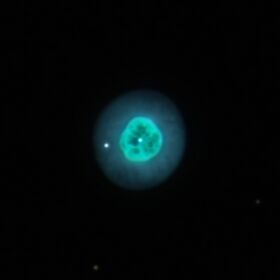Astronomy:NGC 1535
From HandWiki
Short description: Planetary nebula in the constellation of Eridanus
| Emission nebula | |
|---|---|
| Planetary nebula | |
 NGC 1535 using the 0.8m Schulman Telescope from the Mount Lemmon SkyCenter Credit: Adam Block/Mount Lemmon SkyCenter/University of Arizona | |
| Observation data: J2000 epoch | |
| Right ascension | 04h 14m 15.782s[1] |
| Declination | −12° 44′ 21.68″[1] |
| Distance | 5500–7500 ly (1740–2310[2] pc) |
| Apparent magnitude (V) | 10.5[1] |
| Apparent dimensions (V) | 0.650′ × 0.611′[1] |
| Constellation | Eridanus |
| Designations | 2MASX J04141578-1244216, IRAS 04119-1251, PN G 206.4-40.5, PK 206-40.1, dML87 112, UITBOC 627, VERA J0414-1244 |
NGC 1535 is a planetary nebula in the constellation of Eridanus, discovered by William Herschel on February 1, 1785.[3] It is very similar to the Eskimo Nebula in both color and structure but the central star can be quite difficult to observe visually.[4]
At the center of NGC 1535, there is an O-type star with a spectral type of O(H)5.[5]
References
- ↑ 1.0 1.1 1.2 1.3 "NGC 1535". SIMBAD. Centre de données astronomiques de Strasbourg. http://simbad.u-strasbg.fr/simbad/sim-basic?Ident=NGC+1535.
- ↑ Smith, H. (9 April 2015). "On the distances of planetary nebulae". Monthly Notices of the Royal Astronomical Society 449 (3): 2980–3005. doi:10.1093/mnras/stv456. Bibcode: 2015MNRAS.449.2980S.
- ↑ Seligman, Courtney. "Celestial Atlas: NGC Objects: NGC 1500 - 1549". http://cseligman.com/text/atlas/ngc15.htm#1535.
- ↑ "Best of AOP - Planetary Nebulae: NGC 1535". NOAO. http://www.caelumobservatory.com/obs/n1535.html.
- ↑ González-Santamaría, I.; Manteiga, M.; Manchado, A.; Ulla, A.; Dafonte, C.; López Varela, P. (2021). "Planetary nebulae in Gaia EDR3: Central star identification, properties, and binarity". Astronomy & Astrophysics 656: A51. doi:10.1051/0004-6361/202141916. Bibcode: 2021A&A...656A..51G.
External links
- "NGC 1535". University of Arizona. http://skycenter.arizona.edu/gallery/nebulae/ngc1535.
- "Cleopatra's Eye (NGC 1535)". http://observing.skyhound.com/archives/dec/NGC_1535.html.
 |

